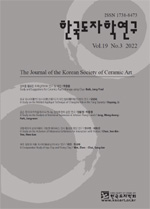존슨 창의 도자작품에서 드러나는 감정표현에 관한 연구
A Study on the Analysis of Emotional Expression in Johnson Tsang’s work
- 한국도자학회
- 한국도자학연구
- Vol.19 No.3
-
2022.1231 - 49 (19 pages)
-
DOI : 10.22991/ksca.2022.19.3.31
- 81

모든 인류가 필수적으로 지닌 감정은 사람의 생활과 밀접한 관계가 있으며, 인간 뇌의 가치 관 계에 관한 주관적인 반영을 나타내는 것으로, 인류의 생존과 발전에 매우 중요한 의의를 지닌다. 이러한 감정은 인간성의 자연스러운 표현이며, 예술에 있어 감정표현은 예술가의 생활, 시대, 역 사적 배경 등과 깊은 관계성을 드러낸다. 하지만 중국에서는 지금까지 예술 활동에 있어 개인의 감정이 집단의 규범이나 사회적 분위기에 의해 그 중요도나 공감이 크게 드러나고 있지 못하는 실정이다. 이에 본 연구는 이러한 사회적 한계점을 극복하고 있는 중국 홍콩 작가 존슨 창 (Johnson Tsang)의 작품연구를 통해 작가가 추구하는 개인적 감정표현의 중요성을 탐구하고 그 표현 과정을 분석하고자 한다. 먼저 감정과 미술표현의 관계성을 정의한 후, 감정표현의 요소에 대하여 분류한다. 2장에서는 현대 중국미술에서 나타나는 감정표현의 흐름을 파악한다. 마지막으 로 작가가 감정과 예술을 결합하는 방식과 감정을 구현시켜내는 제작기법을 분석한다. 이를 통해 현대의 중국미술에서 개인의 감정표현이 갖는 의의를 확인할 뿐만 아니라, 더 나아가 감정표현 방법에 대한 발전 가능성 탐구에 연구의 목적이 있다.
Emotions essential to all human beings are closely related to human life and represent a subjective reflection of the human brain's value relationship, which is very significant to the survival and development of mankind. These emotions are a natural expression of humanity, and in art, emotional expressions reveal a deep relationship with the artist's life, times, historical background, and so on. However, in China, the importance or empathy of individual emotions in artistic activities are not greatly revealed by the norms or social atmosphere. Thus, this study seeks to explore the importance of the artist's personal expression of emotion and analyze the expression process through the work of Johnson Tsang, a Hong Kong artist in China, who is overcoming these social limitations. First, the relationship between emotion and art expression is defined, and then the method of expression of emotion is classified. Chapter 3 examines the flow of emotional expression in contemporary Chinese art. Lastly, it analyzes the way the artist combines emotions and art and the production techniques that embody emotions. Through this, the purpose is not only to identify the significance of individual expression of emotion in modern Chinese art, but also to explore the possibility of development in emotional expression methods.
Ⅰ. 서론
Ⅱ. 중국미술과 감정표현
Ⅲ. 존슨 창(Johnson Tsang, 曾章成)
Ⅳ. 결론
참고문헌
(0)
(0)